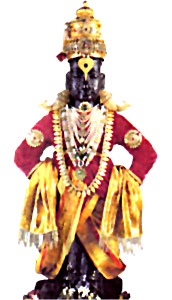Vithoba is a sacred and popular sage, worshipped mostly in Maharashtra, Andhra Pradesh and Karnataka. Lord Vithoba has several names such as Vitthala, Panduranga and Pandhari, but he is fondly known as Vithoba. Usually Vithoba is revered as one of the incarnations of Lord Vishnu or Krishna; at different stages he is also linked with Lord Siva or Buddha. Vithoba Temple in Pandharpur, Maharashtra, Vitthala Temple, Hampi, in Karnataka and Thennangur Temple, in Tamil Nadu are some important temples present in India. Millions of devotees from all over the country come for a glimpse of Lord Vithoba during the festivals of Ashadhi Ekadashi or Shayani Ekadashi and Kartik Ekadashi or Prabodini Ekadashi.
 Lord Vithoba is portrayed as a dark young boy, standing on a brick with the hands on the hips, sometimes accompanied by Rukmani, his main companion. He wears a tulsi-bead necklace with fish-shaped earrings. Pandharpur image depicts a conch in his left hand and a lotus in his right hand, which is either naked or a cloth is present around the waist of the image, whereas the other images depict the traditional right hand gesture of blessing, clothed in a yellow dhoti along with several gold ornaments.
Lord Vithoba is portrayed as a dark young boy, standing on a brick with the hands on the hips, sometimes accompanied by Rukmani, his main companion. He wears a tulsi-bead necklace with fish-shaped earrings. Pandharpur image depicts a conch in his left hand and a lotus in his right hand, which is either naked or a cloth is present around the waist of the image, whereas the other images depict the traditional right hand gesture of blessing, clothed in a yellow dhoti along with several gold ornaments.
There are a lot of theories about the origins and meanings of the names of Lord Vithoba. Few believe that Lord Vithoba came to Pandharpur due to the devotee Pundalik, a historical figure and creator of Varkari cult. According to Varkari etymology, the name Vitthala is composed of two different Sanskrit and Marathi words: vit and thal, meaning `brick` and `standing` respectively. This would mean `one standing on a brick` and justifies the image of Pandharpur.
However, according to saint-poet Tukaram, Vitthala is composed of two different words `vittha` meaning ignorance and `la` meaning one who accepts. Combining both it becomes `one who accepts innocent people with lack of knowledge`. According to another historian Ramkrishna Gopal Bhandarkar, the name Vitthala and Vithoba came from the combination of two languages Kannada and Marathi. Earlier these people adopted each other`s language. Vittu or Vithu is a Kannada name of Lord Vishnu and its suffixes -la and -ba is a Marathi word meaning father. According to few Indologists, Vithoba has emerged as an alternative option to the existing of Brahminical dieties.
Pandharpur Temple in Maharashtra, close to the Karnataka border is a famous temple, dedicated to Lord Vishnu. It is the main centre of worship of Vithoba. The temple is believed to have been built in the 13th century near the bank of river Bhima. The Pandharpur image is depicted as a dark, black young boy. It is a black basalt sculpture that is 3 feet 9 inches tall. The ritual worship is performed by Brahmin priests in five daily rites and the spiritual worship is done by the Varkaries. The other Vithoba temples present in Maharashtra are at Dehu, Kole, Rajapur, Bilra Mandir at Shahad and at Kolhapur.
Lord Vitthala was introduced to South India as Lord Vithoba in the 15th century during the Vijaynagara and Maratha rule. Vijaya-Vittala Temple in Hampi, Karnataka, Vitthaleshwara Temple at Mulbagal, in Karnataka, are some of the famous Vithoba temple.












